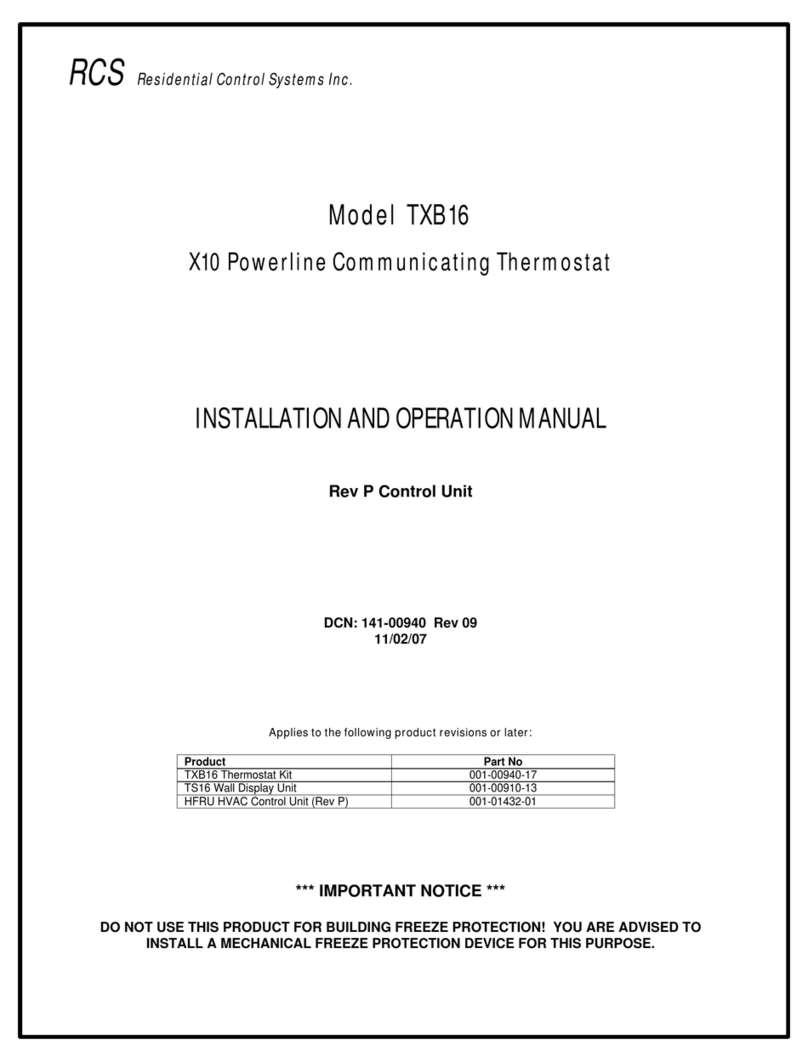
DCN: 141-00930-07 09/06/04 9
MRT times out. However, if the mode is set to Off, the MRT will be canceled and the system will turn off
immediately. The default MRT is set to 6 minutes but can be adjusted by the network system variable
command from 1 to 9 minutes.
Minimum Off Time (MOT). The HVAC control unit has a minimum off time after every heating or cooling
call is completed. This off time is used for short cycle protection to prevent compressor damage after
cooling calls (and heat calls for Heat Pumps). In addition, the MOT helps both Standard and HP systems to
prevent rapid cycling of the system, caused by quick temperature changes. The default MOT time is set to 6
minutes but can be adjusted by the system variable network command from 5 to 9 minutes.
The Status LED on the Control Unit circuit board will flash twice during MOT/MRT periods.
Standard HVAC System Setup
Standard System Mode Selection. To set the Control Unit for standard GAS/ELECTRIC operation, set the
dipswitch SW1 position 1 to the STD SYS position (SW1-1 = OFF).
Fan Mode Selection. Normally, GAS heating systems DO NOT require fan calls along with the heat call
due to automatic fan operation in the furnace. For Gas systems, dipswitch SW1 position 2 should be set to
the OFF position (SW1-2 = OFF).
Electric heating systems generally DO require that a fan call be generated along with the heat call. For these
systems, dipswitch SW1 position 2 should be set to the ON position (SW1-2 = ON). Be sure to check your
HVAC system’s requirements.
TR16 Control Unit HVAC System Outputs for Standard Systems
Operating Mode Outputs (no Fan with Heat) Outputs ( Fan with Heat)
Manual Fan GG
Cooling Stage 1 G, Y1 G, Y1
Cooling Stage 2 G, Y1, Y2 G, Y1, Y2
Heating Stage 1 W1 G, W1,
Heating Stage 2 W1, W2 G, W1, W2
HEAT PUMP HVAC SYSTEM OPERATION
The TR16 has Heat Pump operating modes of Heating, Cooling, Auto changeover and Emergency Heat.
The Heat Pump HVAC system operation is the same as for Standard systems for normal first and second
stage operations. In addition, Heat Pumps may have a third stage of heating, which is for Auxiliary Heat
(such as heat strips). The third stage comes at 5 degrees (default) from setpoint and stays on until
temperature drops to 3 degrees from setpoint.
Emergency Heat Mode. When the Control Unit HVAC System Type is selected as a Heat Pump system,
an additional operating mode of “Emergency Heat” (EH) can be selected from the WDU mode menu. In the
event of a compressor failure, the “EH” mode can be selected. When in this mode, the stage 3 auxiliary heat
(heat strips) output (W1) will be ON in lieu of stage 1 heat calls. Compressor stages 1 (Y1) and 2 (Y2)
outputs are inhibited to protect from further equipment damage. This mode is for temporary use until the
compressor can be repaired.
The EH mode can also be used during extreme low outdoor temperatures when compressor heating is
inadequate and Auxiliary Heat is required for heating operation.




























